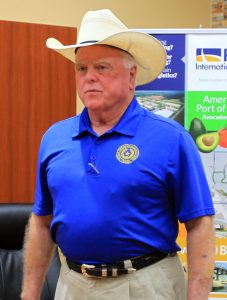
|
Only have a minute? Listen instead
Getting your Trinity Audio player ready...
|
October is National Seafood Month, and the Texas Department of Agriculture is using the occasion to raise awareness about Texas wild-caught shrimp through its “Caught Here, Not Brought Here” multi-media promotional campaign.
No question, the state’s Gulf shrimp industry can use all the help it can get, with no relief in sight from a flood of cheap, farm-raised, imported shrimp, much of it raised under questionable, environmentally unsustainable conditions. The TDA campaign shines a light on this reality while also offering tips to consumers on how to look for Texas wild-caught shrimp on packaging and restaurant menus, recipes, and advice on where to find Texas wild-caught and how to select the best product.
“Choosing Wild Caught Texas Shrimp matters — not just for the superior flavor, but for the positive impact on local shrimpers,” according to the TDA’s campaign web page.
Agriculture Commissioner Sid Miller, discussing the campaign with the Brownsville Herald, said it’s something the department does annually in order to help the struggling industry.
“We’re constantly trying to promote the wild-caught shrimp industry,” he said. “They need a lot of help.”
Miller cited foreign imports as the main factor threatening to destroy the industry, which is fighting battles on many fronts.
“You think of Texas agriculture, you think of cattle and cotton, but it’s also seafood,” he said. “Texas shrimp, Texas oysters. It’s a big part of what we do.”
Miller said the main crux of the campaign is to help consumers distinguish between farm-raised, imported and organic, wild-caught Texas shrimp. The state’s shrimp industry still directly supports around 5,000 jobs, though those jobs are in jeopardy because the cost of production is exceeding revenue generated, he said.
“The high input cost is the thing that’s really killing them,” Miller said. “The cost to get it to market is more than what the market will pay them for it. You can’t stay in that business model very long … They’ve been hurting now for quite some time. We’ve lost a tremendous amount of the market share because of inferior quality imports that come in.”
Texas shrimping is at least a $260 million industry, he said, adding that he hopes his department’s efforts are getting some traction.
“We’re doing our very best to make it count,” Miller said. “We’re doing everything we can to help them out, to distinguish the high quality of wild caught shrimp.”

Consumers would be less inclined to eat imported shrimp if they knew the conditions much of it is raised in, he said, adding that Congress needs to impose stricter inspection protocols with shrimp, just as was done with imported catfish years ago.
“About a third of the imports are rejected, but the problem is we don’t destroy them,” Miller said. “They can take them back, re-label them and send them back again and they’ve got a 75% chance of getting them through. That needs to change. … Now 90% of all of our shrimp is imported. We have a superior product right here, but it all boils down to cheap product.”
He said he believes Congress can be prodded to respond, even if it hasn’t yet with regard to shrimp imports.
“I think we can,” Miller said. “I’ve certainly been reaching out. So far it’s been on deaf ears, but we’re going to continue to make that case. It’s I think an easy case to make, if we’re going to lose a whole industry. It’s not just Texas. We’re not on the mountain by ourselves. Other Gulf states, from Florida all the way around that have shrimping seasons.”
He said his department would do everything possible to prevent the state’s shrimp industry — important culturally as well as economically — from disappearing.
“You just want a level playing field,” Miller said. “Right now they don’t have that.”
Maria Barrera-Jaross, executive director of the Texas Shrimp Association, applauded TDA’s efforts to bring awareness to the industry.
“Texas shrimpers produce the best shrimp in the world,” she said. “This campaign will highlight the importance and benefits of purchasing high-quality, wild-caught shrimp compared to foreign, farm-raised shrimp that is overwhelmingly imported into this country.”
For more information go to txgulfseafood.com/shrimp/.



